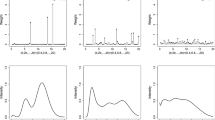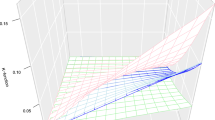Abstract
This paper describes the package sppmix for the statistical environment R. The sppmix package implements classes and methods for modeling spatial point patterns using inhomogeneous Poisson point processes, where the intensity surface is assumed to be a multiple of a finite additive mixture of normal components and the number of components is a finite, fixed or random integer. Extensions to the marked inhomogeneous Poisson point processes case are also presented. We provide an extensive suite of R functions that can be used to simulate, visualize and model point patterns, estimate the parameters of the models, assess convergence of the algorithms and perform model selection and checking in the proposed modeling context. In addition, several approaches have been implemented in order to handle the standard label switching issue which arises in any modeling approach involving mixture models. We adapt a hierarchical Bayesian framework in order to model the intensity surfaces and have implemented two major algorithms in order to estimate the parameters of the mixture models involved: the data augmentation and the birth–death Markov chain Monte Carlo (DAMCMC and BDMCMC). We used C++ (via the Rcpp package) in order to implement the most computationally intensive algorithms.







Similar content being viewed by others
References
Baddeley A, Turner R (2005) spatstat: an R package for analyzing spatial point patterns. J Stat Softw 12(6):1–42. http://www.jstatsoft.org/v12/i06/
Baddeley A, Rubak E, Turner R (2015) Spatial point patterns: methodology and applications with R. CRC Press, Boca Raton
Barndorff-Nielsen OE, Kendall WS, van Lieshout MNM (1999) Stochastic geometry, likelihood and computation. Chapman and Hall, London
Benes V, Bodlak K, Møller J, Waagepetersen RP (2005) A case study on point process modelling in disease mapping. Image Anal Stereol 24:159–168
Berliner L (1996) Hierarchical Bayesian time-series models. Fund Theor Phys 79:15–22
Bivand RS, Pebesma E, Gomez-Rubio V (2013) Applied spatial data analysis with R, 2nd edn. Springer, New York. http://www.asdar-book.org/
Cappé O, Robert CP, Rydén T (2003) Reversible jump, birth-and-death and more general continuous time Markov chain Monte Carlo samplers. J R Stat Soc B 65:679–700
Chakraborty A, Gelfand AE (2010) Measurement error in spatial point patterns. Bayesian Anal 5:97–122
Chiu SN, Stoyan D, Kendall WS, Mecke J (2013) Stochastic geometry and its applications, 3rd edn. Wiley, London
Celeux G, Hurn M, Robert CP (2000) Computational and inferential difficulties with mixture posterior distributions. J Am Stat Assoc 95(451):957–970
Cressie N (1993) Statistics for spatial data, 2nd edn. Wiley, London
Cressie N, Wikle CK (2011) Statistics for spatio-temporal data. Wiley, Hoboken
Daley DJ, Vere-Jones D (2005) An introduction to the theory of point processes, volume I: elementary theory and methods, 2nd edn. Springer, New York
Daley DJ, Vere-Jones D (2008) An introduction to the theory of point processes, volume II: general theory and structure, 2nd edn. Springer, New York
Dellaportas P, Papageorgiou I (2006) Multivariate mixtures of normals with unknown number of components. Stat Comput 16:57–68
Dempster AP, Laird NM, Rubin DB (1977) Maximum likelihood from incomplete data via the EM algorithm. J R Stat Soc B 39:1–38
Diebolt J, Robert CP (1994) Estimation of finite mixture distributions by Bayesian sampling. J R Stat Soc B 56:363–375
Diggle PJ (2013) Statistical analysis of spatial and spatio-temporal point patterns, 3rd edn. Chapman and Hall, London
Diggle PJ, Moraga P, Rowlingson B, Taylor BM (2013) Spatial and spatio-temporal log-gaussian cox processes: extending the geostatistical paradigm. Stat Sci 28(4):542–563
Eddelbuettel D, Sanderson C (2014) RcppArmadillo: accelerating R with high-performance C++ linear algebra. Comput Stat Data Anal 71:1054–1063
Eddelbuettel D, François R, Allaire J, Chambers J, Bates D, Ushey K (2011) Rcpp: seamless R and C++ integration. J Stat Softw 40(8):1–18
Escobar M, West M (1995) Bayesian density estimation and inference using mixtures. J Am Stat Assoc 90:577–588
Frühwirth-Schnatter S (2006) Finite mixture and Markov switching models. Springer, Berlin
Gelfand AE, Diggle PJ, Fuentes M, Guttorp P (eds) (2010) Handbook of spatial statistics. CRC Press, Boca Raton
Green PJ (1995) Reversible jump Markov chain Monte Carlo computation and Bayesian model determination. Biometrika 82:711–732
Hossain MM, Lawson AB (2009) Approximate methods in Bayesian point process spatial models. Comput Stat Data Anal 53:2831–2842
Jasra A, Holmes CC, Stephens DA (2005) Markov chain Monte Carlo methods and the label switching problem in Bayesian mixture. Stat Sci 20:50–67
Ji C, Merly D, Keplerz TB, West M (2009) Spatial mixture modelling for unobserved point processes: examples in immunofluorescence histology. Bayesian Anal 4:297–316
Illian JB, Hendrichsen DK (2009) Gibbs point process models with mixed effects. Environmetrics. https://doi.org/10.1002/env.1008
Illian J, Penttinen A, Stoyan H, Stoyan D (2008) Statistical analysis and modelling of spatial point patterns. Wiley, Chichester
Illian J, Sørbye S, Rue H (2012) A toolbox for fitting complex spatial point process models using integrated nested Laplace approximation (INLA). Ann Appl Stat 6(4):1499–1530
Keribin C, Brault V, Celeux G, Govaert G (2015) Estimation and selection for the latent block model on categorical data. Stat Comput 25(6):1201–1216
Kottas A, Sanso B (2007) Bayesian mixture modeling for spatial Poisson process intensities, with applications to extreme value analysis. J Stat Plan Inference 137:3151–3163 (Special issue on Bayesian inference for stochastic processes)
Liang S, Carlin BP, Gelfand AE (2009) Analysis of Minnesota colon and rectum cancer point patterns with spatial and nonspatial covariate information. Ann Appl Stat 3:943–962
Lindgren F, Rue H, Lindström J (2011) An explicit link between Gaussian fields and Gaussian Markov random fields: the SPDE approach. J R Stat Soc Ser B. https://doi.org/10.1111/j.1467-9868.2011.00777.x
Marin J-M, Mengersen K, Robert CP (2005) Bayesian modeling and inference on mixtures of distributions. Handb Stat 25:459–507
McLachlan G, Peel D (2000) Finite mixture models. Wiley-Interscience, New York
Micheas AC, Wikle CK, Larsen DR (2012) Random set modelling of three dimensional objects in a hierarchical Bayesian context. J Stat Comput Simul. https://doi.org/10.1080/00949655.2012.696647
Micheas AC (2014) Hierarchical Bayesian modeling of marked non-homogeneous Poisson processes with finite mixtures and inclusion of covariate information. J Appl Stat 41(12):2596–2615
Møller J, Waagepetersen RP (2004) Statistical inference and simulation for spatial point processes. Chapman and Hall, Boca Raton
Møller J, Waagepetersen RP (2007) Modern statistics for spatial point processes. Scand J Stat. https://doi.org/10.1111/j.1467-9469.2007.00569.x
Møller J, Helisova K (2010) Likelihood inference for unions of interacting discs. Scand J Stat 37:365–381
Nychka D, Furrer R, Paige J, Sain S (2015) Fields: tools for spatial data. R package version 9.0. https://doi.org/10.5065/D6W957CT, www.image.ucar.edu/fields
Pebesma EJ, Bivand RS (2005) Classes and methods for spatial data in R. R News 5(2). https://cran.r-project.org/doc/Rnews/
R Core Team (2016). R: a language and environment for statistical computing. R Foundation for Statistical Computing, Vienna, Austria. http://www.R-project.org/
Rathbun SL, Shiffman S, Gwaltney CJ (2007) Modelling the effects of partially observed covariates on Poisson process intensity. Biometrika. https://doi.org/10.1093/biomet/asm009
Richardson S, Green PJ (1997) On Bayesian analysis of mixtures with an unknown number of components (with discussion). J R Stat Soc Ser B 59:731–792
Robert CP, Casella G (2004) Monte Carlo statistical methods, 2nd edn. Springer, Berlin
Rue H, Martino S, Chopin N (2009) Approximate Bayesian inference for latent Gaussian models by using integrated nested Laplace approximations (with discussion). J R Stat Soc B 71:319–392
Sethuraman J (1994) A constructive definition of Dirichlet priors. Stat Sin 4:639–650
Scricciolo C (2006) Convergence rates for Bayesian density estimation of infinite-dimensional exponential families. Ann Stat 34:2897–2920. https://doi.org/10.1214/009053606000000911
Spodarev E (2013) Stochastic geometry, spatial statistics and random fields. Springer, Berlin
Stephens M (1997) Bayesian methods for mixtures of normal distributions. Ph.D. thesis, University of Oxford
Stephens M (2000) Bayesian analysis of mixture models with an unknown number of components—an alternative to reversible jump methods. Ann Stat 28:40–74
Tanner M, Wong W (1987) The calculation of posterior distributions by data augmentation. J Am Stat Assoc 82:528–550
Taylor BM, Diggle PJ (2014) INLA or MCMC? A tutorial and comparative evaluation for spatial prediction in log-Gaussian Cox processes. J Stat Comput Simul 84(10):2266–2284
Taylor BM, Davies TM, Rowlingson BS, Diggle PJ (2013) lgcp: Inference with spatial and spatio-temporal log-Gaussian Cox processes in R. J Stat Softw 52(4). http://www.jstatsoft.org/v52/i04
Taylor BM, Davies TM, Rowlingson BS, Diggle PJ (2015) Bayesian inference and data augmentation schemes for spatial, spatiotemporal and multivariate log-Gaussian Cox processes in R. J Stat Softw 63(7):1–48. http://www.jstatsoft.org/v63/i07/
Wickham H (2009) ggplot2: Elegant graphics for data analysis. Springer, New York
Wikle CK, Berliner L, Cressie N (1998) Hierarchical Bayesian space-time models. Environ Ecol Stat 5(2):117–154
Wikle CK, Anderson CJ (2003) Climatological analysis of tornado report counts using a hierarchical Bayesian spatiotemporal model. J Geophys Res 108(24):9005. https://doi.org/10.1029/2002JD002806
Wolpert R, Ickstadt K (1998) Poisson/gamma random field models for spatial statistics. Biometrika 85:251–267
Yao W (2012) Model based labeling for mixture models. Stat Comput 22:337–347. https://doi.org/10.1007/s11222-010-9226-8
Zhou Z, Matteson DS, Woodard DB, Henderson SG, Micheas AC (2015) A spatio-temporal point process model for ambulance demand. J Am Stat Assoc 110(509):6–15
Acknowledgements
We are grateful to three reviewers for their constructive comments and suggestions, and an Associate Editor and the two Editors, Drs. Sakamoto and Symanzik.
Author information
Authors and Affiliations
Corresponding author
Electronic supplementary material
Below is the link to the electronic supplementary material.
Rights and permissions
About this article
Cite this article
Micheas, A.C., Chen, J. sppmix: Poisson point process modeling using normal mixture models. Comput Stat 33, 1767–1798 (2018). https://doi.org/10.1007/s00180-018-0805-z
Received:
Accepted:
Published:
Issue Date:
DOI: https://doi.org/10.1007/s00180-018-0805-z




